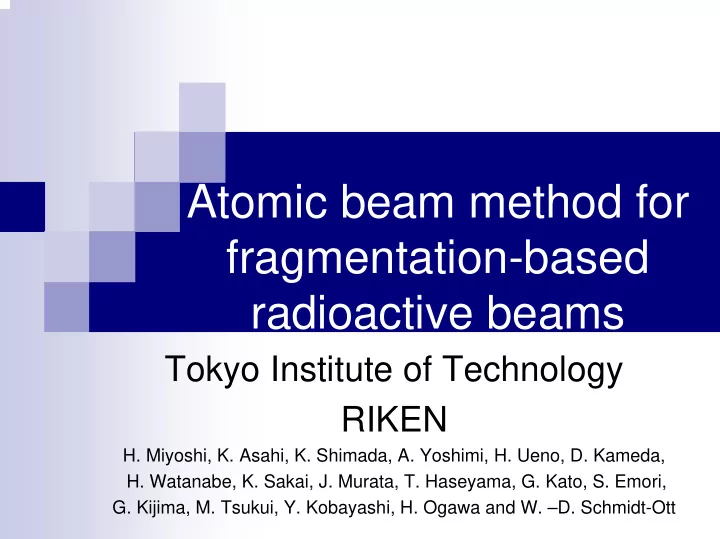

Atomic beam method for fragmentation-based radioactive beams Tokyo Institute of Technology RIKEN H. Miyoshi, K. Asahi, K. Shimada, A. Yoshimi, H. Ueno, D. Kameda, H. Watanabe, K. Sakai, J. Murata, T. Haseyama, G. Kato, S. Emori, G. Kijima, M. Tsukui, Y. Kobayashi, H. Ogawa and W. –D. Schmidt-Ott
Motivation ・ Searching for mechanism of nuclear structures precise measurements of nuclear electromagnetic moments in a wide range ・ Atomic dynamics of surface Atomic dynamics of surface and and interface material interface material. β -NMR technique 、 γ -PAC method 、 Mossbauer spectroscopy Requirements : Various particles, Low energy, High spin polarization … SQS04 2
Atomic beam method applied PF products Principles of the method i. Stopping of RNB atoms in a gas cell ii. atomic spin selection by a field gradient iii. rf transition between two levels iv. second spin selection by a field gradient v. detection of the arrival at F by β , γ , or other activities “high-field seekers” “low-field seekers” Stopping & “non- flipped” drifting gas cell (Counter) RF Coil D Cyclotron F "A" Magnet "C" Magnet "B" Magnet (6-pole) (dipole) (quadrupole) “flipped” Projectile Fragmentation Separator SQS04 3
4 Spin Selection RF C SQS04
RF transition = ⋅ + µ ⋅ + µ ⋅ Η ha g g ( ) ( ) ( ) I J J H I H J I 0 0 0 0 a : magnetic dipole hyperfine interactio n constant H : externel magnetic field 0 B 0 F = I + J g : nuclear g factor I F=1 g : electoric g factor J I F=2 Breit-Rabi formula J for I =1/2, J =3/2 1 1 ∆ ν = + µ ∆ ν + E F m h g H h m Xm X 2 1 / 2 m ( , ) / ( / ) ( 1 ) , F J F F 0 0 8 2 where ∆ ν = = − µ ∆ ν a X g g H h 2 | | and ( ) / J I 0 0 SQS04 5
= − µ − µ + E g Bm g Bm Am m J B J I N I I J Static Field First Step = F 1 ν h = F 0 RF Generator Second Step B weak ( ) B strong ( ) E f Zeeman − effect Paschen Back effect SQS04 6
We calculated distribution of the magnetic field by using OPERA code Distribution of magnetic field Sextupole magnet B (pole tip) = 1.3 T 7
We constructed the sextupole magnet and measured the distribution of magnetic field. We compare the measurement data to the OPERA code calculation. The measurement data consistent with the result of calculation. Comparison of the data with calculation Measurement part SQS04 8
Focus point @ 10cm behind 6pole magnet ’Transmission #+’10’cm’ count 120 FWHM = 13 mm m J =+1/2 100 SPIN(1/2-) The simulation of flight position through 80 the sextupole magnet is shown in right figure. 60 We assume that the center velocity is 40 500 m/s. SPIN(1/2+) m J =-1/2 The result shows that the particles which 20 have specific electronic spin can be focused. 0 -3 -2 -1 0 1 2 3 position (cm) Example) A=12 Requirement: Low energy (< 1000 m/s) Flight velocity = 500 m/s SQS04 9
10 3000 l/s 3000 l/s 3000 l/s < 10 -4 Torr ~ 3 Torr 600 l/s ~ 1200 Torr SQS04
RI Stopping and Extraction system RI- -Stopping Chamber Stopping Chamber RI RI- -Separating Chamber Separating Chamber RI Drift- -Efficiency Efficiency Drift Extraction- -Efficiency Efficiency Extraction He: 600 Torr Beam Beam Catcher Catcher Electrodes Electrodes Electrodes ( -200 V ) Electrodes ( -900 V ) ( -100 V ) 10 cm Nozzle Nozzle TMP SQS04 11
TEST Experiment for RI extraction Secondary Beam: 31 Al(>10 4 cps @F2) Δ E vs. TOF spectrum@Holly Degrader@F1 for 31 Al #3(Al, 444.0 mg/cm 2 ) Secondary Beam: 34 P(>10 5 cps @F2) Degrader@F1 for 34 P #1( 30 Al, 221.1mg/cm 2 ) Production Target τ ( 34 P)= 17.9 sec ( 9 Be, 3.0mm) Primary Beam: Q β = 5.4 MeV 40 Ar(95.0 MeV/u) SQS04 12
Measurement of the Extraction-Efficiency Electrodes Catcher 650 V/cm 6.5 V/cm 31 V/cm Beam Momentum ± 1.25% Nozzle 0.5 mm i.d. SQS04 13
Extraction-Efficiency ∆ N = 12 counts N total =3.10 ✕ 10 6 counts Extraction-Efficiency ∆ N/( Ωε) calc Center -6.3cm η ext = N total =(3.87 ± 1.12)x10 -4 For improving efficiency, 1: removing impurities ⇔ neutralization 2: make larger nozzle ⇔ extraction efficiency 3: use heavier mass stopping rare gas (Ne, Ar) ⇔ stopping efficiency Position of the Catcher = -6.4 cm Goal : >10 -2 SQS04 14
Summary � We are developing device which generate “ low-energy polarized RI Atomic beam” . � The device will be available for measurement of electromagnetic moment and material physics and … etc. � We are now testing the RI stopping and extraction system. SQS04 15
Recommend
More recommend